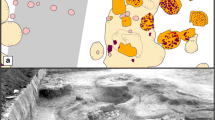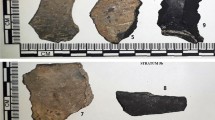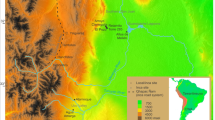Abstract
The Middle Uruk phase in Mesopotamia (3600–3500 bc) has been characterised by the massive production of “bevelled rim bowls” (BRBs). They are characterised by their similar shape and volume in Mesopotamia and surroundings. However, their production method has not been studied in detail, including the firing temperature. The determination of the firing temperature of ancient pottery has been attempted by studying mineral phase transformation sequences; although, very little knowledge exists about such transformations in mixtures or thermal analyses. These methods usually provide imprecise firing temperatures between 500 and 800 °C, as other factors such as the raw materials or firing time and conditions must be considered. As an alternative, luminescence techniques have been tested with promising results, as they have provided reliable maximum firing temperatures for ancient pottery at mild conditions (below 600 °C) with high precision. In this work, the firing temperatures of BRB samples from two archaeological sites located in the Middle Euphrates Valley (Syria) have been studied using mineralogical, chemical and thermal analysis. Both mineral characterization techniques and thermal analyses show agreement and firing probably below 600–700 °C. Luminescence yields ambiguous results but circumstantial evidence on the firing temperature between 400 and 550 °C.










Similar content being viewed by others
References
Aitken MJ (1985) Thermoluminescence dating. Academic, London
Alizadeh A (1985) A protoliterate pottery kiln from Chogha Mish. Iran 23:39–50
Beyer D (1991/2) La campagne 1991 de Tell Ramadi (Syrie), Orient-Express 1991/2, 16
Blackman MJ (1999) Chemical characterization of local Anatolian and Uruk style sealing clays from Hacinebi. Paléorient 25:51–56
Bolger D, Stephen F (1999) Scientific analysis of Uruk ceramics from sites of the Syrian and southeast Anatolian Euphrates: preliminary results. Aula Orientalis Supplementa 15:301–310
Bøtter-Jensen L, Agersnap Larsen N, Mejdahl V, Poolton NRJ, Morris MF, McKeever SWS (1995) Luminescence sensitivity changes in quartz as a result of annealing. Radiat Meas 24:535–541
Bøtter-Jensen L, Bulur E, Duller GAT, Murray AS (2000) Advances in luminescence instrument systems. Radiat Meas 32:523–528
Brodard A, Guibert P, Lévêque F, Mathé V, Carozza L, Burens A (2012) Thermal characterization of ancient hearths from the cave of Les Fraux (Dordogne, France) by thermoluminescence and magnetic susceptibility measurements. Quat Geochronol 10:353–358
Brodard A, Lacanette-Puyo D, Guibert P, Lévêque F, Burens A, Carozza L (2015) A new process of reconstructing archaeological fires from their impact on sediment: a coupled experimental and numerical approach based on the case study of hearths from the cave of Les Fraux (Dordogne, France). J Anthropol Archaeol Sci (available online)
Bulur E (1996) An alternative technique for optically stimulated luminescence (OSL) experiment. Radiat Meas 26:701–709
Burbidge CI, Rodrigues AL, Dias MI, Prudêncio MI, Cardoso G (2010) Optimisation of preparation and measurement protocols for luminescence dating of small samples from a suite of porcelains and faiences. Mediterr Archaeol Ar 10:53–60
Cano NF, Ribeiro RB, Munita CS, Watanabe S, Neves EG, Tamanaha EK (2015) Dating and determination of firing temperature of ancient potteries from São Paulo II archaeological site, Brazil by TL and EPR techniques. J Cult Herit 16:361–364
Charitidis C, Kitis G, Furetta C, Charalambous S (2000) Superlinearity of synthetic quartz: dependence on the firing temperature. Nucl Instrum Methods Phys Res B 168:404–410
Chen R, Yang H, McKeever SWS (1988) The strongly superlinear dose dependence of thermoluminescence in synthetic quartz. J Phys D Appl Phy 21:1452–1457
Daszkiewicz M, van Ess M, Schneider G (2012) Pottery and clay from Uruk, Southern Iraq. Laboratory analysis of pottery fabrics from the Late Uruk to the Seleucid Period. Zeitschrift für Orient-Archäologie 5:90–102
De Benedetto GE, Laviano R, Sabbatini L, Zamborin PG (2002) Infrared spectroscopy in the mineralogical characterization of ancient pottery. J Cult Herit 3:177–186
De Mirochedji P (1976) Un four du IVe millénaire sur le tell de l’Apadana à Suse. Cahiers de la DAFI 6:13–41
Delougaz P, Kantor H (1996) Chogha Mish I, Chicago
Drebushchak VA, Mylnikova LN, Drebushchak TN, Boldyrev VV (2005) The investigation of ancient pottery: application of termal analysis. J Therm Anal Calorim 82:617–626
Drebushchak VA, Mylnikova LN, Molodin VI (2007) Thermogravimetric investigation of ancient ceramics: metrological analysis of sampling. J Therm Anal Calorim 90:73–79
Drebushchak VA, Mynikova LN, Drebushchak TN (2011) The mass-loss diagram for the ancient ceramics. J Therm Anal Calorim 104:459–466
Duminuco P, Messiga B, Riccardi MP (1998) Firing process of natural clays. Some microtextures and related phase compositions. Thermochim Acta 321:185–190
Faivre X (2009) Rations et notion de capacité standard dans la céramique du Proche-Orient. Cahiers des thèmes transversaux ArScAn 9:305–319
Franklin AD, Prescott JR, Scholefield RB (1995) The mechanism of thermoluminescence in an Australian sedimentary quartz. J Lumin 63:317–326
Gartia RK (2009) Paleothermometry of NaCl as evidenced from thermoluminescence data. Nucl Instrum Methods Phys Res 267:2903–2907
Ghazal RO, Kouchoukos N, Speakman RJ, Glascock MD, Descantes C (2008) Production zone sourcing and intraregional exchange of ceramics in the fourth-millennium BC Susiana plain: a case study. In Alizadeh A (ed.) Chogha Mish II. The development of a prehistoric regional center in lowland Susiana, Southwestern Iran. The Oriental Instituto of the University of Chicago, 130. Chicago, pp. 93–99
Goksu HY, Wieser A, Regulla DF (1989) 110°C TL peak records the ancient heat treatment of flint. Ancient TL 7:15–17
Gualtieri ML, Gualtieri AF, Gagliardi S, Ruffini P, Ferrari R, Hanuskova M (2010) Thermal conductivity of fired clays: effects of mineralogical and physical properties of the raw materials. Appl Clay Sci 49:269–275
Gunasekaran S, Anbalagan G, Pandi S (2006) Raman and infrared spectra of carbonates of calcite structure. J Raman Spectrosc 37:892–899
Heimann R (1989) Assessing the technology of ancient pottery: the use of ceramic phase diagrams. Archaeomaterials 3:123–149
Helwing B (2014) Bevelled rim bowls. In Lebeau M. (ed.) ARCANE, Interregional I Ceramics, Turnhout, pp. 31–38
Jamieson A (1989) Experiments in the manufacture of ancient near eastern pottery. Artefacts 13:12–27
Kaalsbeek J (1980) La céramique de série du Djebel Aruda (à l’époque d’Uruk). Akkadica 20:1–11
Kitis G, Kiyak NG, Polymeris GS (2015) Temperature lags of luminescence measurements in a commercial luminescence reader. Nucl Instrum Methods Phys Res B 359:60–63
Kiyak NG, Polymeris GS, Kitis G (2008) LM-OSL thermal activation curves of quartz: relevance to the thermal activation of the 110°C TL glow-peak. Radiat Meas 43:263–268
Kondopoulou D, Aidona E, Ioannidis N, Polymeris GS, Tsolakis S (2015) Archaeomagnetic study and thermoluminescence dating of protobyzantine kilos (Megali Kypsa, North Greece). J Archaeol Sci: Reports 2:156–168
Koul DK (2006) Role of alkali ions in limiting the capacity of the 110°C peak of quartz to remember the firing temperature. Appl Radiat Isotopes 64:110–115
Koul DK, Nambi KSV, Singhvi AK, Bhat CL, Gupta PK (1996) Feasibility of estimating firing temperature using the 110°C TL peak of quartz. Appl Radiat Isotopes 47:191–194
Le Brun A (1980) Les écuelles grossières. État de la question. In: Barrelet, M.-Th. (org.) L’Archéologie de l’Iraq du début de l’époque néolithique à 333 avant notre ère. Editions du Centre national de la recherche scientifique, Paris, pp. 59–66
Liverani M (1998) Uruk, la prima città, Laterza, Roma
Lucovsky G, Manitini MJ, Srivastava J, Irene EA (1987) Low temperature growth of silicon dioxide films: a study of chemical bonding by ellipsometry and infrared spectroscopy. J Vac Sci Technol B 5:530–537
Mackenzie RC (1970) Differential thermal analysis 1 and 2. Academic, London
Maggeti M (1982) Phase analysis and its significance for technology and origin. In: Olin JS, Franklin AD (eds) Archaeological ceramics. Smithsonian Institution Press, Washington DC, pp. 121–133
Maggetti M, Neururer Ch, Ramseyer D (2011) Temperature evolution inside a pot during experimental surface (bonfire) firing. Applied Clay Science, 53:500–508
McDougal DJ (1968) Thermoluminescence of geological materials. London University Press, London, p 678
McKeever SWS (1985) Thermoluminescence of solids, Cambridge University Press, Cambridge, UK, p 376
McKeever SWS (2001) Optically stimulated luminescence dosimetry. Nucl Instrum Methods B 184:29–54
Moorey PRS (1999) Ancient Mesopotamian materials and industries. Eisenbrauns, Winona Lake, IN
Moropoulou A, Bakolas A, Bisbikou K (1995) Thermal-analysis as a method of characterizing ancient ceramic technologies. Thermochim Acta 260:743–753
Ondruška J, Trník A, Medved I (2011a) Estimation of mass transfer parameters during dehydroxylation in a large ceramic body by inverse methods. Ceram Int 37:3299–3305
Ondruška J, Trník A, Vozár L (2011b) Degree of conversion of dehydroxylation in a large electroceramic body. Int J Thermophys 32:729–735
Oniya EO, Polymeris GS, Tsirliganis NC, Kitis G (2012) On the pre-dose sensitization of the various components of the LM-OSL signal of annealed quartz; comparison with the case of 110 °C TL peak. Radiat Meas 47:864–869
Podoba R, Stubna I, Lukovicova J, Bacik P (2012) The firing temperature of Romanesque brick from Pác. J Civ Eng 7:79–86
Pollock S (2015) Ovens, fireplaces and the preparation of food in Uruk Mesopotamia. Origini 37:35–37
Polymeris GS (2016) Thermally assisted OSL (TA-OSL) from various luminescence phosphors; an overview. Radiat Meas 90:145–152
Polymeris GS, Sakalis A, Papadopoulou D, Dallas G, Kitis G, Tsirliganis NC (2007) Firing temperature of pottery using TL and OSL techniques. Nucl Instrum Methods Phys Res A 580:747–750
Polymeris GS, Afouxenidis D, Tsirliganis NC, Kitis G (2009) The TL and room temperature OSL properties of the glow-peak at 110°C in natural milky quartz: a case study. Radiat Meas 44:23–31
Polymeris GS, Oniya EO, Jibiri NN, Tsirliganis NC, Kitis G (2012) Inhomogeneity in the pre-dose sensitization of the 110°C TL peak in various quartz samples: the influence of annealing. Nucl Instrum Methods Phys Res B B 274:105–110
Polymeris GS, Kiyak NG, Koul DK, Kitis G (2014) The firing temperature of pottery from ancient Mesopotamia, Turkey, using luminescence methods: a case study for different grain-size fractions. Archaeometry 56:805–817. doi:10.1111/arcm.12044
Ponikarov VP (e.d.) (1967) The geology of Syria. Part I. Stratigraphy, igneous rocks and tectonics. Ministry of Industry, Damascus, Syria
Postgate JN, Moon JA (1985) Excavations at Abu Salabikh, 1981. Iraq 44:103–136
Potts D (2009) Bevel-rim bowls and bakeries. Evidences and explanations from Iran and the indo-Iranian borderlands. JCS 61:1–23
Preusser F, Chithambo M, Götte T, Martini M, Ramseyer K, Sendezera EJ, Susino GJ, Wintle AG (2009) Quartz as a natural luminescence dosimeter. Earth Sci Rev 97:184–214
Riccardi MP, Messiga B, Duminuco P (1999) An approach to the dynamics of clay firing. Appl Clay Sci 15:393–409
Rice PM (1987) Pottery analysis. The University of Chicago Press, Chicago
Sanjurjo-Sánchez J, Montero Fenollós JL (2012a) Restudying the beveled rim bowls: new preliminary data from two Uruk sites in the Syrian middle euphrates. Res Antiquitatis 3:246–277
Sanjurjo Sánchez J, Montero Fenollós JL (2012b) Chronology during the bronze age in the archaeological site tell Qubr Abu al-‘Atiq, Syria. J Archaeol Sci 39:163–174
Sanjurjo Sánchez J, Fernández Mosquera D, Montero Fenollós JL (2008) TL/OSL dating of sediment and pottery from two Syrian archaeological sites. Geochronometria 31:21–27
Sanjurjo-Sánchez J, Montero Fenollós JL (2014) A late bronze age site and fluvial environmental context in the Middle Euphrates Valley (Northeast Syria). The Holocene 24:743–748
Sanjurjo-Sánchez J, Gómez-Heras M, Polymeris GS (2013) Estimating maximum temperatures attained during fires in building stoneworks by thermoluminescence: a case study from Uncastillo, Saragossa (Spain). Mediterr Archaeol Ar 13:145–153
Sanjurjo-Sánchez J, Gomez-Heras M, Fort R, Alvarez de Buergo M, Izquierdo Benito R, Bru MA (2016a) Dating fires and estimating the temperature attained on stone surfaces. The case of Ciudad de Vascos (Spain) Microchem Jl 127:247–255
Sanjurjo-Sánchez J, Montero Fenollós JL, Prudêncio MI, Barrientos V, Marques R, Dias MI (2016b) Geochemical study of beveled rim bowls from the Middle Syrian Euphrates sites. J Archaeol Sci Reports 7:808–818
Schwartz G (1988) Excavations at Karatut-Mevkii and perspectives on the Uruk-Jemdet-Nasr expansion. Akkadica 56:11
Schwartz M, Hollander D (2008) Bulk stable carbon and deuterium isotope analyses of bitumen artifacts from Hacinebi Tepe, Turkey: reconstructing broad economic patterns of the Uruk expansion. J Archaeol Sci 35:3144–3158
Shoval S, Beck P (2005) Thermo-FTIR spectroscopy analysis as a method of characterizing ancient ceramic technology. J Therm Anal Calorim 82:609–616
Shoval S, Beck P, Kirsch Y, Levy P, Gaft M, Yadin E (1991) Rehydroxylation of clay minerals and hydration in ancient pottery from the ‘land of Geshur’. J Therm Anal 37:1579–1592
Shoval S, Gaft M, Beck P, Kirsh Y (1993) Thermal behaviour and monocrystalline calcite tempers during firing and their use in ancient vessels. J Therm Anal 40:263–273
Spencer JQ, Sanderson DCW (1994) Mapping thermal exposure by luminescence thermometry. Radiat Meas 23:465–468
Spencer JQG, Sanderson DCW (2012) Decline in firing technology or poorer fuel resources? High-temperature thermoluminescence (HTTL) archaeothermometry of Neolithic ceramics from Pool, Sanday, Orkney. J Archeol Sci 39(2012):3542–3552
Stefanaki EC, Hatzikraniotis E, Vourlias G, Chrissafis K, Kitis G, Paraskevopoulos KM, Polymeris GS (2016) Thermal stability study from room temperature to 1273 K (1000 °C) in magnesium silicide. Metall Mater Trrans A A 47:5146–5158
Stein GJ, Hollander D, Schwartz M (1999) Reconstructing Mesopotamian exchange networks in the 4th millennium BC: geochemical and archaeological analyses of bitumen artifacts from HacinebiTepe, Turkey. Paléorient 25:67–82
Stephen FMK, Peltenburg E (2002) Scientific analyses of Uruk ceramics from Jerablus Tahtani and other Middle-Upper Euphrates sites. In: Postgate JN (ed.) Artefacts of complexity. Tracking the Uruk in the Near East. Britich School of Archaeology in Iraq, pp. 173–190
Strommenger E (1980) Habuba Kabira. Eine Stadt vor 5000 jahren, Philipp von Zabern, Mainz am Rhein, p 86
Sunta CM, David M (1982) Firing temperature of pottery from pre-dose sensitization of TL. PACT vol 6:460–467
Theodosoglou E, Koroneo A, Soldatos T, Zorba T, Paraskevopoulos KM (2010) Comparative Fourier transform infrared and X-ray powder diffraction analysis of naturally occurred Kfeldspars. Bulletin of the Geological Society of Greece, Proceedings of the 12th International Congress, Patras, pp. 2752–2761
Warashina T, Higashimura T, Maeda Y (1981) Determination of the firing temperature of ancient pottery by means of ESR spectrometry. In: Hughes MJ (ed) Scientific studies in ancient ceramics, BAR occasional paper, 19. British Museum, London, pp. 117–128
Watson IA, Aitken MJ (1985) Firing temperature analysis using the 110°C peak of quartz. Nucl Tracks 10:517–520
Wilson MA, Hoff WD, Hall C, McKay B, Hiley A (2003) Kinetics of moisture expansion in fired clay ceramics: a time^1/4 law. Phys Rev Lett 90:1–4
Wilson MA, Carter MA, Hall C, Hoff WD, Ince C, Savage SD, McKay B, Betts IM (2009) Dating fired-clay ceramics using long-term power law rehydroxylation kinetics. P Roy Soc A-Math Phy 465:2407–2415
Wilson MA, Hamilton A, Ince C, Carter MA, Hall C (2012) Rehydroxylation [RHX] dating of archaeological pottery. P Roy Soc A-Math Phy 468:3476–3493
Yu RS, Ito K, Hirata K, Sato K, Zheng W, Kobayashi Y (2003) Positron annihilation study of defects and Si nanoprecipitation in sputter-deposited silicon oxide films. Chem Phys Lett 379:359–363
Zimmerman J (1971) The radiation induced increase of the 110°C TL sensitivity of fired quartz. J Phys C Solid State 4:3265–3276
Acknowledgments
This research has been funded by projects “Investigaciones Arqueológicas en el Medio Éufrates” (HAR210-15866, Ministry of Economy and Competitiveness, Spain) and “Expedición arqueolóxica da UDC no Medio Éufrates Sirio” (10PXIB 167197PR, Xunta de Galicia, Spain). The University Institute of Geology of the University of A Coruña (Spain) also received support from the Xunta de Galicia with funds from “Consolidación y estructuración de unidades de investigación competitivas: Grupos de potencial de crecimiento” (GPC2015/024) and Redes de investigación (R2014/001).
The present manuscript has been previously submitted for publication to Geoarchaeology. Despite the rejection, the authors would like to thank the two reviewers for their constructive and fruitful comments. Based on these comments, the quality of the manuscript has been substantially increased. Finally, the authors acknowledge the helpful comments of both reviewers of the present submission.
Author information
Authors and Affiliations
Corresponding author
Rights and permissions
About this article
Cite this article
Sanjurjo-Sánchez, J., Montero Fenollós, J.L. & Polymeris, G.S. Technological aspects of Mesopotamian Uruk pottery: estimating firing temperatures using mineralogical methods, thermal analysis and luminescence techniques. Archaeol Anthropol Sci 10, 849–864 (2018). https://doi.org/10.1007/s12520-016-0409-x
Received:
Accepted:
Published:
Issue Date:
DOI: https://doi.org/10.1007/s12520-016-0409-x




